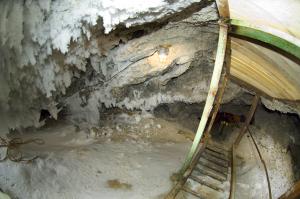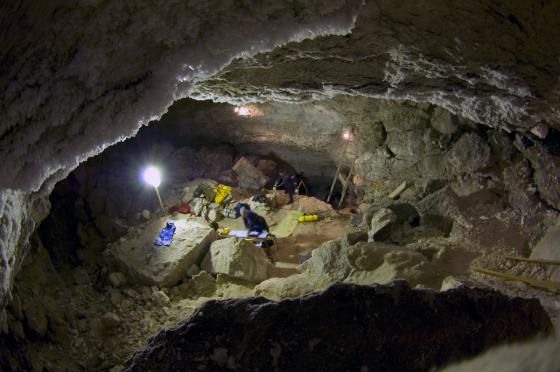
As Cold As It Gets: Cave Diving in Siberia in February

When you go cave diving in Siberia in February you need to learn it's not safe to get drunk and then go outside to pee by yourself at night, and that you have to freeze-proof your regulator. In that order.
On a chilly fall morning in North Florida, my Russian sidemount students Evgeniy Runkov and Sergey Andreev chuckled when I asked if they were warm enough during decompression. “You must come to Russia to see what our cave diving is like!”
As simple as that, the deal was sealed. A few short months later, I was facing winter on the Siberian frontier while my warm Russian hosts organized a trip to Russia’s longest underwater cave system.
I sought diving advice from friends who had visited Russia. Instead, I got advice about how to survive the sport of vodka drinking.
“Eat lard, raw eggs, a stick of butter, never downgrade, stay away from beer and especially wine. And after you eat the raw eggs and lard, don’t get too active. If you jump around, the alcohol breaks through. Then you are in real trouble!”
What I really wanted to know was - should I wear dry gloves or neoprene for the dry caving prior to getting in the water? Should I ice prep my regs?
“It is alright to pass out drunk, not okay to pass on drinking,” I was told. “They’ll be flattered if you land tits-up in a snow bank, but don’t go outside without a buddy… it will be about minus 30 degrees.”
On the night before departure, my telephone rang with a recorded message from the Gilchrist County Emergency Management Office. We were expecting some bad weather through the night – tornadoes, microbursts, torrential rain. As I journeyed to the airport the following morning, the radio echoed the bad news. A high school collapsed. A team bus ran off the road. Tornadoes killed dozens. Everyone at the airport complained about the horrible weather. I stopped at a bookstore to buy a book on global warming, hoping for some good news that perhaps Siberia might be thawing. No such luck. More bad news. Sometimes global warming causes unusually cold winters. Was I crazy to visit Russia in February?
But as most trips unfold, the pre-trip visualizations rarely reflect the actual experience. What I found in Russia was a warmhearted community of eager divers, thirsting for information and experience from their Western counterparts. I also discovered a hard-core team of cave divers whose tenacity and talent rival the best in the world.
Travel time to Ekaterinberg, Russia was over 32 hours. Ekaterinberg is the historical and economic center of the Ural Mountains, which form a natural border between Europe and Asia. The last Russian Czar, Nikolai II and the Romanov family, were assassinated by Bolsheviks there July 1918. During the years of World War II, the city turned into a huge arsenal of military technology and armaments.
Another dramatic episode in the area took place on May 1, 1960 when American U2 spy plane pilot Francis Gary Powers was hit by a missile launched from the local military base. The city was closed to the outside world until the early 1990s because of its strategic defense industries.
In Ekaterinberg, I met up with the members of the Ural Cave Diving Team and embarked on a day-long journey to our cave diving site.
Ordinskaya Cave is located near the southwest edge of the village of Orda in the Perm Region of Russia. The opening to the cave is located in the Kazakovskaya Mountain Massif, which overlooks the Kungur River. Karst sinkholes dot the surface of the massif and large springs bubble out of ferocious sand boils in the river below. The linear direction of flow from the cave is unloading its forces towards Arsenovskiy Spring approximately 2000 feet east of the cave entrance. This spring discharges significant volumes (300 l/sec.) of water but has not been connected through exploration at this juncture.
The cave entrance is located on the steep southern slope of the mountain in a karst sinkhole collapse approximately 40 feet in diameter and 30 feet in depth. From the entrance, visitors stumble down a talus cone of clay and gypsum mixed with snowmelt and dramatic sublimation ice crystals. A rough covered stairway protects entrants from falling rocks, which increase in frequency as the sun warms the ice slope above the entrance.

A series of stairs, ice covered ladders and rock piles lead the diver down to a large hall perched above the Ice Lake entrance to the underwater cave. After gearing up in a chamber which rarely rises above –15°C, one last ladder gives the diver access to the water.
Limestone and dolomite are exposed in the walls of the cave in addition to delicate gypsum covered with sparkling ice crystals. Dry gypsum halls rarely exceed 50-foot diameters and collapses occur frequently, but the massive white underwater passages have much larger cross-sections than their dry counterparts.
But underwater sections of Ordinskaya Cave are still very delicate. Collapses occur regularly, especially during spring and autumn rains. One infamous collapse brought down a five-ton plate of gypsum on the main guideline, sealing the exit for a cave diving team. Luckily the 60-foot deep passages allowed for ample time to conduct a lengthy search to find a new exit.
Visitors wanting to enjoy good visibility should aim to dive the cave in February when clarity and stability are at their peak. The second best season for diving is reported to be August when topside conditions, described as “green winter,” actually feature temperatures that can rival great American heat waves.
The first cave scientists to visit Orda were Andrei Samovolnikov and Igor Lavrov, arriving in 1993 to research new leads in the Perm region of Russia. Following information from locals, they began exploring and surveying dry passages in Ordinskaya Cave. With the assistance of Perm, Kungur and Moscow speleologists, they made a detailed map of 1000 feet of dry halls, but were stopped by several underground lakes in the cave.
In the spring of 1994 Victor Kamarov, a Moscow cave diver, was invited to inspect frozen underground lakes in the system. Kamarov and Lavrov had to borrow tools from local ice fishermen to cut a small hole through the ice covering the underground lake. Armed with a 50 cubic foot cylinder and only 200 feet of guideline, Kamarov quickly discovered he was completely under-equipped. After tumbling through a crack into the main cave conduits, he found vast tunnels with snow-white walls filled with crystal clear water. He knew immediately that many return trips would be in order. Within a few short years, Ordinskaya became the longest underwater cave in Russia and the longest underwater gypsum cave in the world.
In 1996, serious exploration began with three separate cave diving teams from Krasnoyarsk, Chelyabinsk and Moscow working in tunnels in different directions. Prior to 1998, the longest underwater penetration by a Russian cave diver was around 2000 feet. During the late nineties, as access to equipment and training increased, several explorers reached the limits of three different conduits at approximately 3000-foot penetrations. Although the distances may not seem great to North American cave divers, the near freezing waters made these dives significant undertakings.
Recently, the Ural Cave Diving team has further lengthened the cave with new exploration and side-mount diving techniques. As these divers find ways to manage their thermal protection, they will undoubtedly increase penetrations even further. Today, Ordinskaya cave boasts over 13,000 feet of surveyed passage.
I did not anticipate diving on my first day, but we drove straight to the cave site and started prepping gear. Luckily jet lag and excitement allowed me to lose track of time. By the time we entered the water, the sun was dropping below the horizon. When we exited the cave, it was to a crisp night with a blazing full moon.

The most difficult part of the cave diving at Ordinskaya is the walk out of the cave. As your suit freezes solid, you quickly lose mobility. The steps are very icy and a missed footing could send you more than a hundred feet straight down to the frozen riverbed. As you climb, you desperately tear at your neck seal to allow the cold air to flush through - anything to gain an extra breath.
The Ice Lake entry pool is small. Four people fill the area quickly but an entire team must prepare together since every minute of immersion is a losing battle with the cold. If the team has to wait on a diver in the water, then minutes are lost from comfortable dive time.
The entrance to the cave is through a pile of breakdown rubble. Single-file divers drop down the boulders feet-first until entering a large room approximately 30 feet across. The guideline is made of heavy rope so that gloved hands can easily grip and feel the line. Translucent white rocks laid down in heavy layers, yield a breathtaking first impression. Many passages are more than 100 feet across and the water in these rooms is crystal clear.
The Ural Cave Diving Team spent almost three years removing and replacing the original guideline in the cave. The earliest explorers used any material they could get their hands on, and that included parcel string and wire. The end result was a confusing maze of dangerous routes with ensnaring guidelines that could not be cut, and fragile string that was falling apart. Replacing the line was a thankless job, but has resulted in a safe, well-defined route system with proper jumps, gaps and line markers.
The Ural Cave Diving Team is an assemblage of talented and highly motivated men dedicated to the safety and adventure of cave diving. Their day jobs range from running a taxi and recreational vehicle empire to computer specialties, engineering, real estate and entrepreneurship. Their drive and intelligence in their occupations carry over into their zest for adventure and the technical challenges of cave diving in a frontier.
The primary goal of the Ural Cave Diving Team is to foster conservation and exploration of local cave systems like Ordinskaya, and to encourage others to pursue higher levels of training to create a strong record of safety in the region.
Written by Jill Heinerth, Florida.